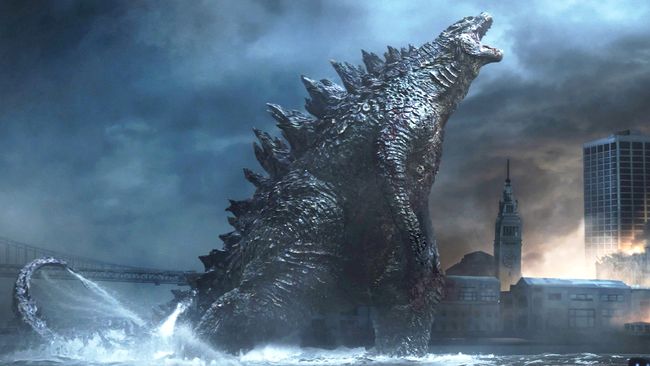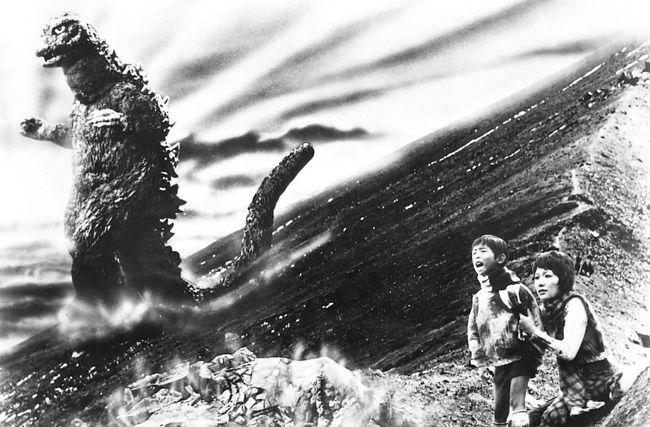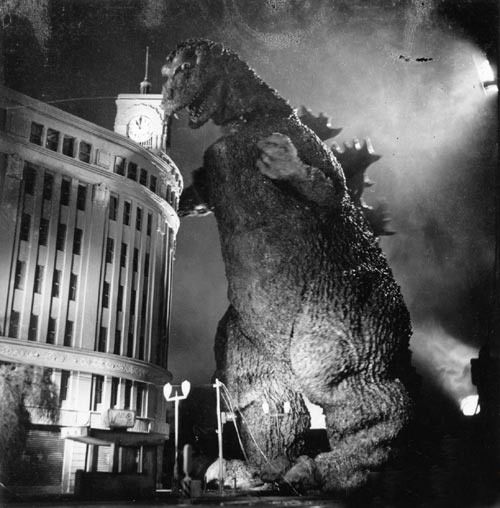Twenty ninth. A story of one monster
A remarkable and funny event has happened in Japan: Godzilla has been given the title of an honorary citizen
Godzilla is a movie character. Moreover, it is not a human being, but a huge pangolin. It can be asserted with complete certainty that millions of audience all over the world would define it in the same way. What is the reason of its more than 50-year-long popularity?
In 1951 The Saturday Evening Post published Ray Bradbury’s short story The Fog Horn. It tells about a sea monster attacking a lighthouse after being attracted by the siren (the fog horn).
In 1953 Warner Bros. Studio released a black-and-white catastrophe film The Beast from 20,000 Fathoms (Director: Eugene Lourie); only the scene of ruination of the lighthouse remained there from Bradbury’s plot. The masters of visual effects made the monster look like a hybrid of a tyrannosaurus and stegosaurus. The pangolin is called Rhedosaurus; woken up by an explosion of a nuclear bomb, it is heading towards the eastern coast of the US, destroying the fishing boats on its way. The only witness of the existence of the monster is pronounced a lunatic. Meanwhile, the Rhedosaurus attacks Manhattan. Only a shell with radioactive isotope is able to destroy the beast. The largest part of the budget, 200,000 out of 210,000 dollars, was used for the design of the Rhedosaurus. The film scores a box office of five million dollars.
In the same year Tomoyuki Tanaka, one of the producers of the Japanese Toho Film Company watched The Beast from 20,000 Fathoms and decided to make a similar film in Japan. As a result, in 1954 a giant mutant born as a result of hydrogen bomb tests, resistant to bullets and shells, able to shoot high-temperature fire from his mouth appeared on screen; it was called Gojira (Gojira – from Japanese “gorira” (gorilla) and “kujira” (whale)) – it was the nickname of one of Toho employees.
The first black-and-white Godzilla always enters the lists of best films, and the thing is not about the first usage of the genre. The attack of the giant becomes a nationwide catastrophe. The pictures of hospitals, full of wounded and burnt people, remind of the chronicle of the aftermaths of the nuclear bombings of Hiroshima and Nagasaki, and the fire in Tokyo in 1944. The radio announces a mourning day, a desperate funeral song is played, which is also the ending song of the film. The way to fight the evil is no better than the cause of the disaster: professor Serizawa invents a “destructor of oxygen,” which destroys any flesh it gets in contact with, and the scientist has to commit suicide to prevent anyone from getting the lethal substance. The ending looks as a requiem for those who were killed in the World War Two.
The film of 1954 practically exhausted the entire content volume which such a plot could contain: man and nature, civilization responsibility, war, the weapons of mass destruction. Further entertainment remained.
To keep the interest of the audience, a quantity increase of attractions was needed. In the following film Godzilla fights against another pangolin. Since then more than one monster is present in all of the parts of the cycle; the anomaly fauna receives the mark kaiju, a “strange beast” or a “monster.” In the tokusatsu film industry (visual effects, stories about super heroes) a genre appears which is called “kaiju eiga.” The first colored film King-Kong is made in 1962 and scored the box office 70 times higher than the budget. After Ghidorah, the Three-Headed Monster (1964) aliens become one of the sides of the conflict (nine films on the whole) – as a rule they fight for gaining control over kaiju, to use them against the earthlings.
On the whole, the Japanese canon of “godzilliada” includes 28 movies, with 15 ones shot in the first 20-year-long period. Over the time Godzilla’s physiology has become more detailed: from the initial 50 meters its height increased up to 110; like all dinosaurs it has an additional brain in the pelvis part, its life energy is sustained by a biological nuclear reactor. It is practically impossible to kill Godzilla. Kaiju eat rarely, and they don’t defecate or copulate.
In the late 1950s the atmosphere of the sequels changes according to the aspirations of the producers to embrace as wide market as possible. In Ghidorah, the Three-Headed Monster Godzilla supports people for the first time. The anthropomorphic features are emphasized in its behavior. In Invasion of Astro-Monster (1965) after fighting back the annoying Ghidorah, the pangolin starts dancing and roaring in content, in another episode he is boxing in Mohammed Ali’s style, and in Big Duel in the South Seas (1966), it even dances rock’n’roll after destroying a fighter squadron.
The youth revolt in the 1960s gave way to Godzilla vs. Hedorah (Yoshimitsu Banno, 1971). This movie differs so much from the previous ones that it is worth of giving a closer look.
The action starts with a boy playing Godzilla toys near a home altar, all covered with kaiju statuettes. In a sense, this world is shown through the eyes of the child, but we can rather speak about childhood as a world perception, because it is hippie time, a time of “flower children” who mock at values of adults. Ecology serves as a kind of new Apocalypses: the film starts and ends with a merry song about kaiju in the background of hopelessly polluted sea. The litter monster (Smog) grows in these polluted waters, starts ravening cars, pouring the surroundings with sulphuric acid, and, with grimaces of a lover of toxic substances, inhaling the smoke from the plant tubes.
Godzilla vs. Hedorah is pierced with irony which is close to absurd. The dirty stains on the water are repeated by psychedelic amebas, which fill the screen during the head song; suddenly a stuffed swan and other strange items are found on the bottom of the sea; the story is interrupted by scenes which follow the logic of narcotic delirium: animation insertions with mischievous Smog, fragmenting the picture into a multi-screen with fretful babies, transitions from black-and-white to color, and back. The litter thrown away by the flying garbage can behaves as a living organism, and a group of tidy bourgeois get stuck in it upside down, but a lonely cat stays alive. Banno makes Godzilla fly for the first and the last time over 60 years: in a cosmic pose of an embryo, the super pangolin is using its ray as a reactive engine to fly.

THE YOUTH REVOLT IN THE 1960s GAVE WAY TO GODZILLA VS. HEDORAH (YOSHIMITSU BANNO, 1971). THE FILM IS PIERCED WITH IRONY WHICH IS CLOSE TO ABSURD. BANNO MAKES GODZILLA FLY FOR THE FIRST AND THE LAST TIME OVER 60 YEARS: IN A COSMIC POSE OF AN EMBRYO, THE SUPER PANGOLIN IS USING ITS RAY AS A REACTIVE ENGINE TO FLY
Orthodox admirers rejected the film, finding it an eccentric exclusion. However, Banno changed everything, finally asserting the image of Godzilla as a man-like colossus.
The kaiju eiga style envisages the presence of scientists, military men, politicians, and journalists among the leading characters. They are inventing the ways to fight abnormal aggressors, fight (more often unsuccessfully), approve difficult decisions, and tell the world about the intervention, respectively. The necessary scenes of panic evacuation and two battles at minimum: Godzilla with an army and Godzilla with another kaiju. Finally, (Godzilla vs. Gigan, 1972) huge robots fight against the monsters.
There is no doubt that this is a film of patriarchal society. Men are the only people able to fight. The man-created stereotype of vulnerability, intuition, and sincerity is left for women – which is why they are most often shown as telepaths, mediums, priestesses, or fairies. At the same time there are no sex scenes. However, in Terror of Mechagodzilla (1975) woman’s bare breasts are shown for a second, and in Godzilla and Mothra: The Battle for Earth (1992) the leading characters are a married couple, but none of that has been repeated later.
The actors’ work is stereotypical. Military men are supposed to be manly and laconic, the understanding of responsibility makes the facial muscles of a politician stiff, a villain must wear sunglasses and have an unpleasant laugh, and a woman must be beautiful and passive. The dialogs are simple as well. The ending is often emphasized by a weighty sentence: “We created it, so it’s us who are the monsters, not Godzilla,” “Godzilla lives in every one of us.”
The extensive development gradually led the project to a dead end. The cycle run out of ideas and turned into a dump of plots borrowed from Hollywood. As a result, the franchise was closed or an undefined period of time. However, before that time kaiju had won enough admirers beyond Japan.

IN 1954 JAPANESE FILM DIRECTOR ISHIRO HONDA MAKES A FILM ABOUT A GIANT MUTANT BORN AS A RESULT OF HYDROGEN BOMB TESTS; IT WAS CALLED GOJIRA (GOJIRA – FROM JAPANESE “GORIRA” (GORILLA) AND “KUJIRA” (WHALE)) – IT WAS THE NICKNAME OF ONE OF TOHO EMPLOYEES
Before that, tokusatsu was not yet popular in America. In Roland Emmerich’s Godzilla (1998), a hypertrophied iguana without any special powers is vulnerable to earthly weapons. More interesting works that are not connected with the Japanese product directly, but exploit its images and dramaturgy are Cloverfield (Matt Reeves, 2008) and Pacific Rim (Guillermo del Toro, 2013).
Cloverfield is a locality in New York City’s Central Park, where a video camera with documented catastrophe was found. Reeves radically reconsidered the story about kaiju: he implemented a low-budget style with an imitation of documentary shooting and unknown actors. According to the plot, the film was shot on an amateur camera by one of the heroes.
Reeves changes the angle of observation, reduces the terrible things for the sake of human things, distinguishes from a panic-ridden crowd a group of ordinary citizens who have no idea what is going on and react spontaneously. The innovation is in this change: to see the catastrophe through the eyes of several figures from the mass of people. Hence special attention to details: served tables of Manhattan restaurants covered with concrete crumbles, an empty tourist carriage pulled by a white horse along the street, a shocked runaway shouting at the heroes in Belarusian. There is no explanation why the monster came; as if it melted together from the debris of buildings, the dust of falling walls, it is not a source of fear, but actually the fear itself, the projection of neuroses, which struck root in New York after September 11 and even earlier: this is an ever-present mythology of Manhattan – the premonition of an inevitable collapse of this place. Cloverfield is a talented inversion of tokusatsu practically in everything, up to the final.
Guillermo del Toro in Pacific Rim borrows from the Japanese kaiju (they are called here like this), the aliens – they break through a parallel dimension through a breach in earth crust, and piloted robots, for the first time used in Terror of Mechagodzilla (1974).
The aliens in Pacific Rim do not simply control kaiju – they grow them. Pairs of pilots control the robots, called hunters. The gene-modified giants come more improved every time. The victory is, as usual, a result of team efforts and personal sentiments. The level of the show is quite bearable, and the general aesthetics has also been preserved. There are typical of the genre crazy scientists, a rascal businessman who built a whole industry using kaiju, rapacious small fry from the escort of the monsters. The principle difference is that the kaiju are totally deprived of individuality, they act exclusively as live weapons of the invaders. The robust Hollywood moral squares all the accounts in the finale.
Godzilla of 1998, Pacific Rim, and Cloverfield were approaches to the super task – the revival of the super pangolin on a different coast of the Pacific Ocean. Last year the Legendary Studio released its Godzilla.
British Gareth Edwards who began as an independent director took all the requirements of the genre into consideration. The plot is based on a family drama: the father of the leading character, nuclear engineer (Bryan Lee Cranston, famous Walter White from the Breaking Bad series) loses his wife (Juliette Binoche) in a mysterious accident at a nuclear power plant in Japan in 1999 and puts his life to find out what happened in reality. His son (Aaron Taylor-Johnson), a military miner, joins the search and gets into the epicenter of the events.
Edwards sticks to the tradition of “good Godzilla,” who fights on the side of people against other kaiju called Muto, which look like a 90-meter tall predator insect. At the same time it includes the realities that are close to the American audience: conspiracy theories – it turns out that all the nuclear tests of the 1950s were aimed at killing Godzilla; evolutionism – Godzilla and Muto appeared not as a result of a bomb explosion, but in prehistoric time; the army is ready to shoot, paying no attention to intellectuals, thus putting in danger the lives of civilians; the heroes are driven above all by love to fatherland, rescue of humankind is on the second place.
Edwards puts maximum fantasy in kaiju: fragments their appearance in the picture, shows the battle between Muto and Godzilla from many angles – through windows, on television, in the background – and also adds twilight patina to the battle episodes, which is why the monster look like gargoyles that came to life, and the entire scene looks like a gigantomania hallucination. The human figures are colorless, but a lot of efforts were put to depict the beasts – from the rich modulations in their voices to scales on their claws. Edwards all the time shows the beasts in comparison with other objects, which allows him to produce impressive scenes: a pangolin king swims across the ocean next to the accompanying ships of the US Armed Forces, which seem to be real toys compared to it; the battle planes are falling from the sky like rubbish; Muto falls into the ocean like an inhuman arrow sent by an infuriated god; two kaiju were tramping on the runway of the San Francisco Airport. Godzilla possesses unheard-of grace, it uses its ray rarely, but with efficiency of infernal Luna park. Edwards managed to do what nobody did before him: to bring Godzilla out of the Japanese cradle to Hollywood. A new time may start for kaiju. There are plans to shoot a sequel, and the fourth period is already being called Legendary.
Why is it coming back again and again? There are several reasons.
Fetish: for starting from 1971 Godzilla has been a hero of mass culture: commercialized and thus neutralized danger.
Megalopolis – a perfect decoration for any cataclysm, especially for the invasion of a giant beast. If there are skyscrapers, why cannot one imagine a predator roaming against these decorations? Apart from that, a living mountain with fire on the top is an eruption, a volcano, and other cataclysms that have been present in Japan: earthquakes, typhoons, nuclear catastrophes. In a certain sense, Godzilla is after-war Japan, traumatized by nuclear bombing in the same way, and similarly unperceivable from the point of Western rationalism.
Finally, Godzilla’s uniqueness lies in the unity of scientific and fantastic things: legends about a dragon and legends about a dinosaur. Dragons have been left in the fantasy preserve; simply a dinosaur would be not so interesting. Godzilla that came from the ocean is nature that has outmatched the man and at the same time it combines water and fire, the most powerful primordial matters.
Its power is in legends about water and fire that never grow old, in the eternal half-childish desire to see the largest of the beasts. Time will pass, the exciting visual effects will seem ridiculous, but the king will rise again from the ocean, to call the new generations of audiences with a victorious hymn of destruction.
Newspaper output №:
№44, (2015)Section
Culture





